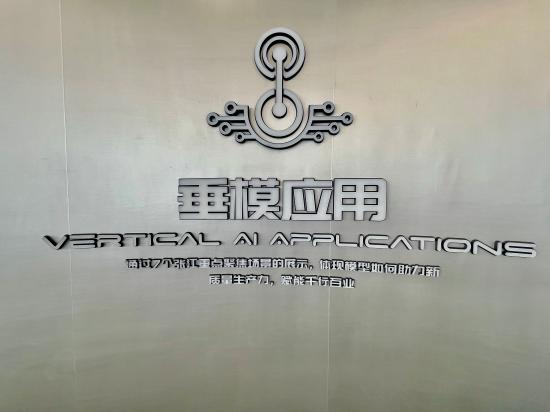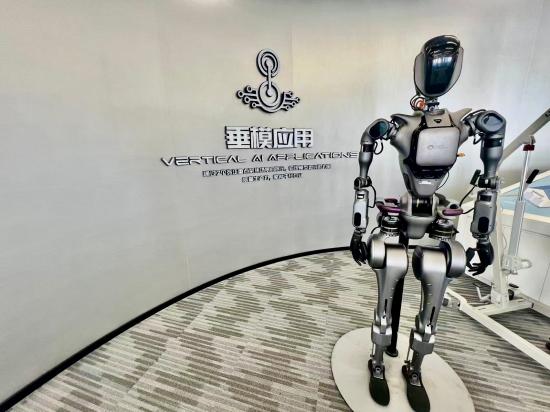BY Li Jiajia from CNS
In National and Local Co-built Humanoid Robotics Innovation Center located in Shanghai’s Pudong New Area, engineers are immersed in various simulation training for the humanoid robot “Qinglong”, such as pre-walking testing and automatic sorting and debugging.

Also in Pudong New Area, Fourier, a general purposerobotics company, recently released a new generation of self-developed general humanoid robot GR-2. Compared with the first generation, GR-2 has brought innovation and improvement in many key links such as hardware, design, and development framework.
The Pudong New Area, as the ‘densest’ area for humanoid robots in Shanghai, is dedicated to advancing the development of this sector by expediting the planning and arrangement of complete robotic systems, intelligent software, hardware core components, and other related aspects.
The scale of the humanoid robot industry in Pudong New Area has exceeded 20 billion yuan, according to the statistics from local committee of science, technology and economy.
In 2023, out of the 12 humanoid robots released in China in 2023, 4 were from Pudong New Area.
In terms of intelligent software, there are a number of leading domestic high-performance computing chip enterprises and more than 30 large-scale model enterprises gathering in Pudong New Area.
As for hardware core components, Pudong New Area’s research and development (R&D) and manufacturing capabilities in high-value links such as actuators, sensors, and dexterous hands are increasingly strong, and it has leading domestic actuator R&D and manufacturing enterprises and a group of high-precision sensor R&D and manufacturing enterprises.
“2024 is the first year of the explosion of the humanoid robot industry, because after the release of Tesla's ‘Optimus’ and the appearance of ChatGPT, the superposition of the two technologies has suddenly increased the attention of the industry”, said Zhu Xing, COO of National and Local Co-built Humanoid Robotics Innovation Center.

The fundamental technologies and control technologies of artificial intelligence have seen significant progress in 2024, achieving a combination with large-scale model technology and successful demonstrations in industrial and home applications, thus providing a greater space for the industry's development, according to He Bin, professor of China’s Tongji University.
“Humanoid robots will become human's best assistants, capable of performing all tasks that humans can do,” said Zhu.
For example, in industrial production, from simple repetitive tasks such as screwing and gluing to complex tasks such as precise assembly and advanced machine operation, humanoid robots will be able to handle them all in future. In particular, humanoid robots will be able to complete tasks in dangerous, toxic, and harmful work environments, such as working in environments with nuclear radiation or hazardous chemicals. Zhu believes that this may be the biggest advantage of humanoid robots over early quadruped robots.
Compared with small-size humanoid robots, the mechanical structure and algorithm control difficulty of large-size humanoid robots increase exponentially. “The higher and heavier it is, the harder it is,” said Zhu.
Most companies' humanoid robot products are still have light weight and small bodies, while National and Local Co-built Humanoid Robotics Innovation Center keeps manufacturing humanoid robots with height and weight that is higher than the current industry average. For example, the humanoid robot “Qinglong” is 185cm tall, weighs 80kg and has 43 active degrees of freedom.
As a strategic emerging industry, humanoid robots have a significant industrial driving role and substantial growth potential. In Shanghai, a city with a foundation in high-end manufacturing and a comprehensive supply chain and industrial support infrastructure from Yangtze River Delta, as well as a wealth of university resources and a talented workforce, there is a favourable environment for accelerating the development of humanoid robots industry.
Taking National and Local Co-built Humanoid Robotics Innovation Center as an example, it plans to establish a humanoid robot industry fund with a total of more than 10 billion yuan.
The center is also building a training ground in Pudong New Area that can accommodate 100 humanoid robots for simultaneous intelligence training and will be able to meet 1,000 humanoid robots for simultaneous training by 2027.
He believes that China can make a difference in humanoid robots, as long as its existing manufacturing capabilities and integration capabilities are played, and it achieves technological breakthroughs in the key basic fields of computing power and algorithms.